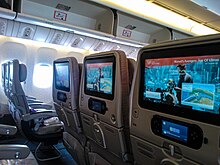
Back الترفيه خلال الرحلة Arabic Entreteniment a bord Catalan In-flight Entertainment German Divertissement en vol French מערכת בידור במטוסי נוסעים HE In-flight entertainment Italian 機内エンターテインメント Japanese 기내 엔터테인먼트 Korean In-flightentertainment Dutch In-flight entertainment NB
This article needs additional citations for verification. (March 2008) |

In-flight entertainment (IFE) refers to the entertainment available to aircraft passengers during a flight. In 1936, the airship Hindenburg offered passengers a piano, lounge, dining room, smoking room, and bar during the 2+1⁄2-day flight between Europe and America.[1] After World War II, food and drink services were offered, and movies were projected onto big screens viewable by all passengers on long flights. In 1985 the first personal audio player became available for purchase, and noise cancelling headphones were introduced in 1989.[2] During the 1990s, the demand for better IFE was a major factor in the design of aircraft cabins. Before then, entertainment came via audio headphone sockets and airline-provided headphones providing music of various genres and the soundtrack of projected movies. Now, in most aircraft, personal IFE display screens are available at most seats, offering entertainment and flight information such as a moving map, speed, and altitude. The advent of small entertainment and communication devices also allows passengers to also use their own devices, subject to regulations to prevent them interfering with aircraft equipment.
Design issues for IFE include system safety, cost efficiency, software reliability, hardware maintenance, and user compatibility.
The in-flight entertainment on board airlines is frequently managed by content service providers.
- ^ Hindenburg interiors
- ^ Bridge, The Broadcast (19 February 2015). "How a "Genius" Engineer Designed the First Noise Cancelling Headsets - The Broadcast Bridge - Connecting IT to Broadcast". www.thebroadcastbridge.com. Retrieved 27 October 2017.